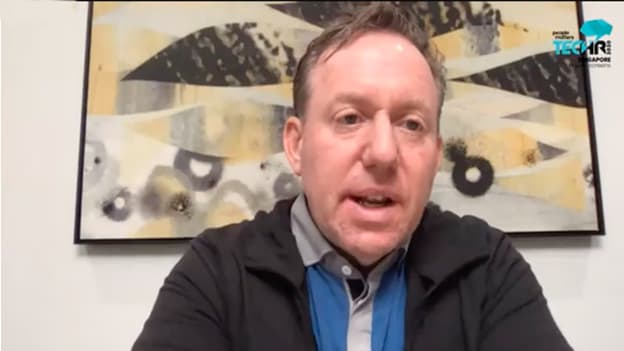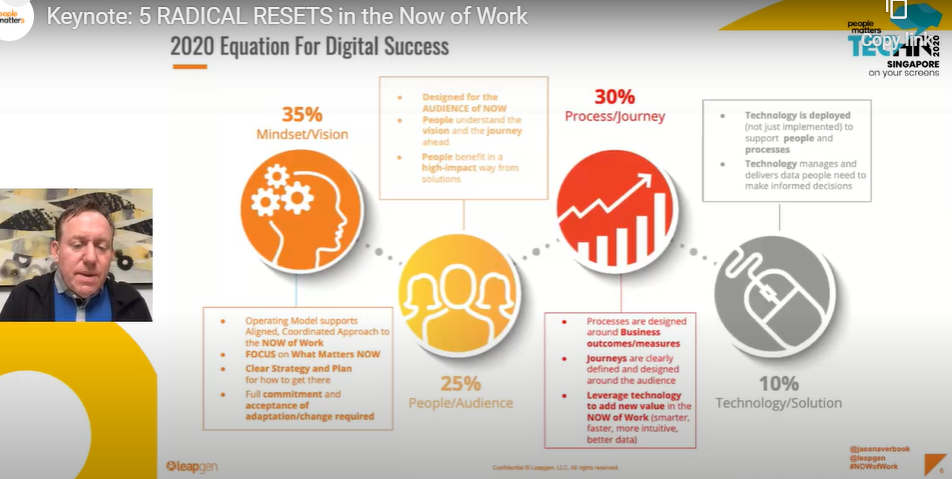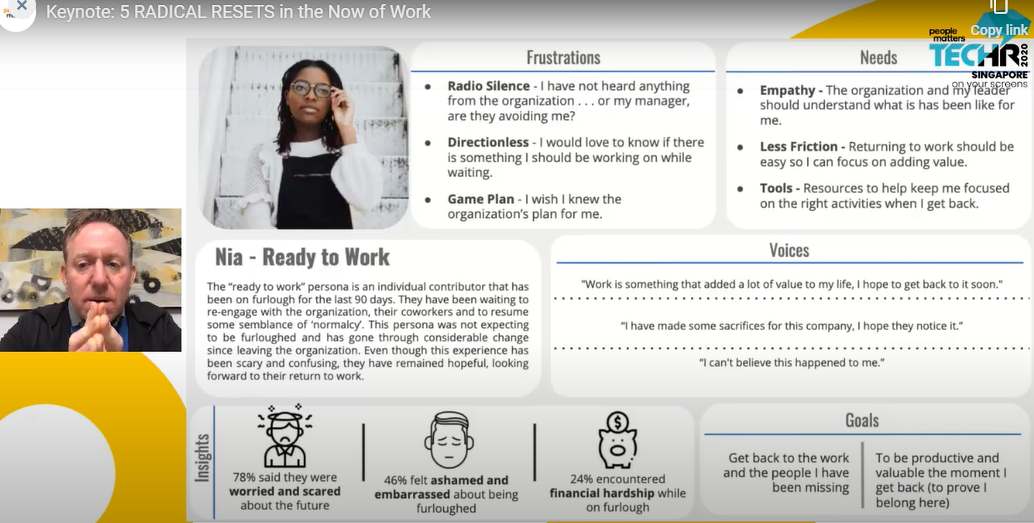To reset HR functions there has never been an opportunity like this: Jason Averbook

A company has to prepare for the future of work but to consolidate the future one has to make the present meaningful. Addressing the virtual audience at People Matters TechHR Conference, Jason Averbook, CEO & Co-Founder, Leapgen said, “We live in the now of work.”
He pointed out the year (Y2K) or the year 2000 when people leaders started talking about the workforce and workplace in 2020 and how it’ll change the work distribution and working experience. But most of them didn’t do anything about it and now the global crisis is here, which moved us into talking about the future of work to talking and living in the now of work.
‘Now of work’
No one can think about the future of work one can only talk about the ‘now’. The way we act on the now together is on three basic elements. We develop strategies, we deploy strategies and then we sustain those strategies by measuring the values.
He shares that the equation for digital success is based on four characteristics. And those characteristics are Mindset/Vision, People/ Audience, Process/Journey, and Technology/Solution.

- The first element is to have a clear mindset and agreed upon a lined mindset with a commitment to change and adaptation because this is the hardest piece.
- The second element is about making sure and designing the right audience and it’s not restricted to HR but designing for the audience of the workforce.
- The third in the priority list is thinking about the journeys and what journeys our workforce goes through as they experience work.
- The fourth one is to see what tech we need to bring that to life but most of us start with technology without having a vision or mindset in place and that’s devastating. It gives tech a huge opportunity to fail and that’s a huge waste of money.
“What we planned on doing in 2020 probably makes no sense any longer. Priorities have changed. Budgets have changed. Intentional sequencing is more important than ever.”
Averbook urged that most of us have changed our plans for this year and rethought what we were doing and not doing the same thing that we have thought earlier this year. Because if we haven’t, then we have to do as it’s going to carry over in 2021.
Here are the five radical resets…….
‘Reset Work’
Work has changed forever and where, how, and when we work has also changed. The workforce has changed forever and what matters to them and why it matters to them has also changed which means we also need to change.
The other thing is that what, why, and how we do businesses has changed forever. Work, workforce, business, the purpose of work has changed forever and top of that humanity is more important than ever before.
What do we do- we must create a new world of experiences for the workforce tied to the new world of business, a new world of workers, and a new world of the workforce.
Here the experience means we are creating a workplace that meets people where they are and make them feel engaged in the work they are doing. The way we design our experiences is to understand our people. In the world and now of our work we must understand that our people are different and are in different places.
A returning employee who is away from work is different as compared to a recruiter and a recruiter is different in comparison to a team manager who has not managed a team for a while and a manager is different from the team which used to be together but now they are distributed. They have changed and we need to put ourselves in their shoes and say guys do these shoes fit?
(For example)

‘Reset budgets’
When it comes to budget the biggest reason that organizations don’t get approval is that they do things in pieces and not with an overall vision. People need to create a vision map to execute the project successfully otherwise they will be just spinning the wheel. A vision map is a set of guiding principles that we use and it’s a way to say that’s how we measure success.
Jason feels that a vision statement should be simple, flexible, equitable, innovative, and proactive. Emphasizing on the vision he mentioned that create and modify your vision now. Audit what you have vs what you need and prioritize and sequence based on now.

‘Reset Leadership’
Reset leadership means that a leader needs to be a futurist and a facilitator. The leader must be thinking about what things might be like in the future and keep people engaged.
Leaders need to bring empathy into the business and to bring empathy one should thank people. Managers in the digital workplace need to stay human. The humanity side is of things is the key. And to do that one must enable productivity vs monitoring activity. You have to trust your people and become the enabler of productivity and not the monitoring police.
Be human and not treat people as machines or robots. Leaders should check-in on them and not check upon. Ask, how are you, and not what are you working on? And make sure that inclusion is infused in our journeys.
‘Reset Trust’
We have to be able to trust our people, our organization, and trust our data. Which means our data must be real-time and relevant. Companies need to engage their people. If people are engaged and they are performing they go at a different speed. Organizations must listen to people and act on them. If we act on people's problems it will build trust.
HR is not in the area of B2B, they are in the B to me. To build trust they should focus on not only being connected but building a connection. Building connections will bring empathy and inject patience.
‘Reset HR’
We have to reset HR. There has never been an opportunity like we have right now to change the industry. We have every reason, opportunity, need desire, and everything that we have ever wanted looking at right into our eyes and saying it’s time to change the function.
It’s time to change the function in a world where we just counted people to a world in which we make must people count. Shifting from counting people to making people count is the big reset for HR.
HR professionals can do this by following three As- Become ‘adaptable’ which means one has to unlearn; Become ‘agile’ in a fragile world which is very hard and lastly, they have to be aggressive.
Organizations and people leaders need to realize that the digital workplace now a big part of HR’s responsibility which needs to be infused into all strategies. Just like the other parts of the workplace was HR’s responsibility digital workplace also comes under HR’s kitty and they must take control of its digital strategy partnering with IT.
In the end, Jason feels that HR should not do a technology transition but make an extra effort and do a digital transformation. The reset of HR is not to create roadmaps or GPS but their role is to create active traffic management.

















